Testing / Performance
Color ***(7.64)*
**To test the color reproduction of the Kodak EasyShare DX7590, we used a GretagMacbeth color chart and Imatest Imaging Software. The chart below depicts the DX7590’s color accuracy, with the outer squares representing the colors produced by the camera, the inner squares standing for the color-corrected version produced by Imatest, and the small vertical rectangle in the middle representing the ideal color tone.
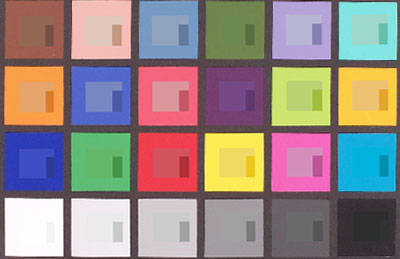
Below is a graphical representation of the 24 color tones produced by the Kodak EasyShare DX7590. The circles represent the camera’s reproduced tones, while the corresponding squares are the ideal colors on the GretagMacbeth chart. The greater the distance between the circle and the square, the less accurate the camera is.
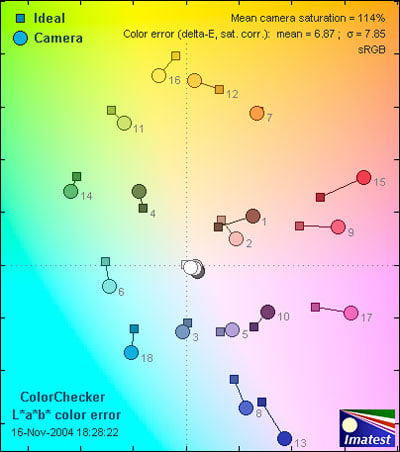
The EasyShare DX7590’s mean saturation score of 114% percent shows us that the camera slightly accentuates the color vibrancy to create more lively images. While this diminishes the camera’s color accuracy a bit, most digital cameras also follow this trend, particularly in the warmer red and pink tones (#15, #9, #7). The 114% saturation score indicates a naturalistic portrayal of color with minimal embellishment. The camera does have some difficulty with cooler colors, like some of the blue and green tones (#13, #8, #18, #6); however, only #13 (Blue) and #18 (Cyan) seem to present problems. Overall, the EasyShare DX7590 received a 7.64 color score and can be counted on to generate consistent, realistic tones with relative accuracy.
**Still Life Scene
**Below is a shot of our standard still life scene taken with the Kodak EasyShare DX7590.
[

Click on the above image above to view a full resolution version (CAUTION: the linked file is very large!)](../viewer.php?picture=KodakDX7590-StillLifeLG.jpg)
**Resolution / Sharpness ***(3.75)*
The Kodak EasyShare DX7590 is equipped with a 1/2.5-inch CCD that has a 4:3 aspect ratio. The CCD has a total of 5.36 advertised megapixels, but uses 4.98 effective megapixels as the largest image size available. Most digital camera manufacturers will use the largest image size available as the camera’s marketed "megapixel count," so we use a slightly altered definition; we report the actual number of pixels used to compose the image. When we conduct our resolution tests to determine the camera’s "true resolution," we contrast the result with the advertised megapixel count. When this is done, cameras that record 70-80% of the total advertised pixels are considered "good" performers, while 80-90% is viewed as "very good" and anything exceeding 90% is "excellent" and quite rare.
When we tested the resolution of the Kodak EasyShare DX7590, it recorded an actual resolution of 3.75 megapixels per image. This is 75% of the advertised pixel count and a very respectable score. The strong resolution capabilities of the DX7590 propel the camera into an elite group within the $500-and-under prince bracket and enable the camera to handle large prints.
Noise Auto ISO ***(3.83)***
The Kodak EasyShare DX7590 received an automatic ISO noise score of 3.83. This reflects an inexcusable degree of noise from a camera for the mid-range user. Unless shooting under abundant light, images taken with the DX7590 in automatic ISO mode will appear distorted and fraught with noise. Because this camera is designed to appeal to both seasoned photographers as well as advancing beginners, the loss of an automatic ISO setting eliminates a large portion of the camera’s potential user base. While the camera does provide four manual ISO settings, and many DX7590 users may opt for the advanced manual control anyway, existing point-and-shoot users are now excluded. This impacts the most likely users of the camera. Though the DX7590’s flexibility, control, and performance appears strong in comparison to automatic point-and-shoot cameras, when contrasted with imagers designed for manual control, the DX7590 barely squeaks into the competition.
Noise Manual ISO ***(6.33)*****
For cameras that have manual ISO settings, we test noise levels at each ISO rating. We compile the noise results into a regression analysis to determine an overall manual noise score. The graph below shows the camera’s ISO settings on the horizontal axis and the amount of noise produced on the vertical axis.

The Kodak EasyShare DX7590 received a 6.33 noise score when shooting under manual ISO settings. This is not as horrible a score as the camera received on the automatic noise tests; however, for the higher-end user, this is barely adequate. Competing models produced by Fujifilm, Sony, and Panasonic seem to handle noise far more effectively and, even with a reduced pixel count, can produce images that appear clearer and more defined. Digital noise appears similar to grain when shooting with film, although it reflects a harsher feel without the warmth and realism attainable with film. Rarely can digital noise pass as anything other than distortion when taking snapshots, portraits, and landscapes. Therefore, beware when shooting with cameras that boast high resolution capabilities without appropriate noise reduction mechanisms. The images may be a disappointment.
Speed Timing
***Start-up to First shot(6.61)*
The Kodak EasyShare DX7590 takes 3.39 seconds to wake up and take its first shot. While it thinks about shooting, it displays an image and makes some music. This is not too quick by current camera standards and will prohibit the impulsive drive to capture the "fleeting moment," as it will likely have passed.
Shot to Shot Time (7.12)
When in normal shooting mode, the camera takes nearly three seconds in between shots. However, once the burst mode is selected via a button on the top of the camera, the Kodak DX7590 only takes 0.54 seconds between each shot. It can shoot three or four pictures at this speed until it has to take a breather and record to the memory card.
Shutter to Shot Time*(8.26)*
From the time the user presses the shutter release button to the time the shutter opens, 0.37 seconds will pass. This is good for a compact camera. Many EasyShare cameras have a much longer lag time from the shutter release to the actual shot.
Physical Tour
**
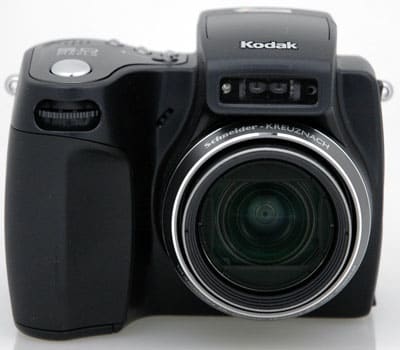
Front ***(8.0)*
The front of the Kodak EasyShare DX7590 is, like many cameras, dominated by its Schneider-Kreuznach Variogon 38-380mm (Equiv.) lens. The 10x optical zoom lens is slightly right of center, with a pop-up flash and self-timer/video light peering above it. To the left of the lens is the right-hand grip, complete with a notched rubber panel so the user’s fingers won’t slide. At the top of the grip is the jog dial, easily accessible to the user’s right index finger. In the extended gap between the grip and the lens are three barely discernible circular indentations, which serve as the microphone.
Back*(8.0)*
The back of the DX7590 frame is far busier than the front, yet contains smaller elements so it appears to have more space. The Kodak EasyShare DX7590 has an electronic viewfinder to the left on the back. The functional viewfinder is large and nicely cushioned by a rubber eyepiece with a diopter adjustment on the left side. To the left is a button marked "EVF/LCD." This button switches the display from the viewfinder to the 2.2-inch LCD screen. The oversized viewfinder protrudes back from the camera far enough to provide adequate spacing from the frame when the user's eye is pressed to it. To the right of the viewfinder is the power button, with the zoom toggle control just to the right of that. The zoom goes wide when pressed left and telephoto when pressed to the right.
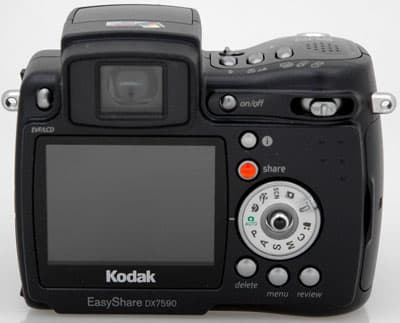
Below the zoom toggle controls is a thumb grip consisting of five raised dots and a series of buttons that control shooting functions. The button near the top to the right of the LCD is the info button. When pressed, it displays information such as image quality setting, exposure compensation, and flash status on the viewfinder or LCD screen. Below the info button is a ruby colored "share" button. Kodak cameras have become synonymous with this handy feature and have built a majority of their digital camera campaign around the feature’s simplicity and intuitiveness. When pressed, a menu appears to permit the user to email or print photographs easily. Below the share button is the mode dial, complete with pictures and letters representing scene modes and manual settings. In the center of the dial is a joystick that moves in all directions for control of the menu options on the LCD screen. The joystick can also be pressed straight in to make a selection. Between the joystick and mode dial is a circle that lights up green to show that the power is on. Below the mode dial are three buttons that line up horizontally. From the left, they are the Delete, Menu and Review buttons — all self-explanatory. **
**

Left Side ***(8.5)*
When viewing this camera from the front, the left side is wide and expansive to provide a stable right-hand grip. The large protrusion houses the battery, which loads from the bottom. The only visible feature from the left side is the port door that opens to the SD/MMC card slot. The door has a slightly raised portion in the center so it can be easily opened and closed. Above the door is a silver loop for lacing a wrist strap or the lens cap.
**
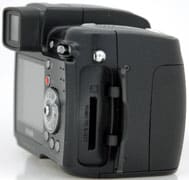
Right Side ***(8.0)*
At the top of the right side of the DX7590’s frame, there is a silver loop similar to the one on the left. It can be used to tie on the lens cap or wrist strap. To the left of the loop is a rubber door for flash accessories. Below is another rubber port cover concealing the DC in, A/V out, and USB cable hookups. Each rubber door has a raised section so it can be easily pried open by the fingers.
**

Top ***(8.0)*
When looking down at the top of the camera from behind, the Kodak EasyShare DX7590's pop-up flash and top of the viewfinder take up the left side. In front of the flash is the Kodak logo. Behind the flash are the words "Kodak Color Science Chip" with a colorful graphic of a cube. On the right side of the top panel is a lighter gray section, highlighted against the black body. At the top of the panel, which covers the top of the right hand grip, is the shutter release button. Below the button are four buttons close to the pop-up flash, and the speaker off to the right. Of the four buttons, the top one slides to open the flash, while the other three are lined horizontally below. From the left, they are the flash settings, macro/ landscape, and bracketing/burst controls. The flash settings button cues a menu when the flash is opened. By pressing the button several times, the user can scroll through the available choices: automatic, on, off, or red-eye reduction. By pressing the middle button, the user can choose among normal, macro, or landscape modes. The button to the right chooses between exposure bracketing or burst mode options.
Components
**

Viewfinder ***(7.5)*
The viewfinder on the Kodak EasyShare DX7590 is electronic with 311,000 pixels. The 0.26-inch viewfinder has a dioptric adjustment, allowing the user to orient the viewfinder’s focus to their personal eyesight. With an electronic viewfinder, what you see is what you get — a good feature for a digital camera. (Some other cameras have optical viewfinders that are located above the lens, so when pictures are framed in the viewfinder, often the lens barrel will appear in the frame.) The button to the left of the viewfinder allows the user to choose between the viewfinder display and the LCD; because they are both electronic, they cannot be viewed simultaneously.
**

LCD Screen ***(8.0)*
Once again, the LCD screen cannot be viewed if the viewfinder is engaged. The Kodak EasyShare DX7590 has a high-resolution 2.2-inch color LCD display with 153,000 pixels. An Info button to the right of the screen allows the user to display the ISO, flash setting, white balance mode, aperture, color setting mode, and other information on the image. This is a large, clear LCD monitor that is not typically included on cameras with "functional" viewfinders. Thus, the visibility provided on this camera is one of its strongest attributes.
**Flash ***(7.0)*
The flash on the Kodak EasyShare DX7590 must be engaged manually. A button to the right of the flash pops it open, which then allows the flash menu to be engaged. By pressing the flash button on top of the camera, the user can cycle through the available settings and select Auto flash, On/Off, or Red-Eye reduction.
**
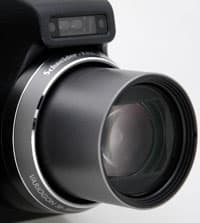
Zoom Lens ***(8.0)*
The Kodak EasyShare DX7590 has a Schneider-Kreuznach 10x optical zoom lens with an aperture of f/2.8-f/8.0. In 35mm format, this is equivalent to a 38-380mm lens. The lens focuses automatically, but quite slowly. At the standard wide angle focal length, the user can focus from 2 feet to infinity. At a standard telephoto angle of view, the user can focus from 6.6 feet to infinity. In the Close Up mode, users can focus from 4.7-27.6 inches in the wide mode and 3.9-6.9 feet in the telephoto mode. The lens also offers a 3x digital zoom, but as with all digital zooms, the image quality will be compromised. The lens has an accessory lens thread inside the lens ring. The Kodak DX7590 has a lens cap attached to the camera with a string. Some users like that feature because they won’t lose the cap; others don’t appreciate the lens cap swinging around while shooting. One potential downside to the excellent zoom capabilities is the lack of image stabilization on the camera. This is only evident when zoomed in full telephoto where minute movements are easily apparent as well as in movie mode. This problem can be easily remedied with a tripod.
Design / Layout
Model Design / Appearance*(7.5)*
The Kodak DX7590 is styled like an SLR, with a smooth, boxy construction that resembles elements of modern architecture. There are indented contours crafted into the camera body to ensure the user keeps a firm grip on the EasyShare DX7590. The camera has a black body with brushed smooth silver highlights. Most of the frame is built from sturdy molded plastic, with added rubber panels for gripping, covering ports, and cushioning the viewfinder. The overall design of the camera body is solid, with the feel of a true SLR encasing the souped-up point-and-shoot imager.
Size / Portability*(6.0)*
This camera comes with a wrist strap, but we cannot recommend dangling the camera on your wrist for long periods of time. Even without the battery and memory card, the Kodak EasyShare DX7590 weighs 12.3 ounces. The body measures 3.9 x 3.2 x 3.2 inches, totaling 39.9 inches3. At this size, the frame feels a bit too bulky to be considered a compact camera. However, with its minimal weight, the camera will feel comfortably transportable around the user’s neck. The size and styling of the DX7590 make the body far too large and awkward for a pocket, and although the camera could fit in a purse, it would fare better if stored in its own camera bag.
Handling Ability*(7.5)*
The Kodak EasyShare DX7590 is boxier than most 5-megapixel cameras because of its SLR-like design. It is smaller than a true digital SLR at 3.9 x 3.2 x 3.2 inches, but still requires two hands to hold securely. The rubber grips and divots in the camera body make for easy handling and advanced control. There is a large right-hand grip to give the user a firm grasp on the frame and necessary stability when shooting. The left hand can comfortably support the camera without obstructing the lens, however, it feels a bit odd without a manual focus ring. The inclusion of a focusing ring would have helped handling and provided advanced control for the camera’s manually-oriented users.
**Control Button / Dial Positioning / Size ***(7.0)*
The camera’s layout is an area in which Kodak DX7590 could improve. The back of the camera has buttons and controls laid out without apparent reason. The exception is the main mode dial; it is large and positioned logically next to the LCD screen. The joystick in the center of the mode dial is small and difficult to use. It is supposed to be pushed up, down, and side to side for navigation and directly depressed into the camera to make a selection. However, because of its size and limited movement, the joystick sometimes presses to the side instead of straight in and vice versa. When engaging the viewfinder, which is larger and far more accessible than others on most recent 5 megapixel cameras, the mode dial and all other buttons for that matter are difficult to identify and control. While this camera wasn’t constructed for speed, changing modes or finding buttons while shooting will require some fancy finger-work.
**Menu ***(7.5)*
To access the menu, the user must depress the Menu button beneath the function dial. Depending on which shooting mode is selected on the function dial, the menu will display an expanded or reduced list of options. The basic menu in automatic and preset modes lets the user choose the self-timer, the image size and quality, exposure compensation, auto focus mode, color mode, and storage album. The manual mode has all of those settings, plus metering, focus zone, white balance, and sharpness. In playback mode, the menu allows the user to select an album for storing the image and decide whether to store the image to the card or internal memory. The Kodak EasyShare DX7590 can protect files so they’re not accidentally erased. Images can be viewed in a slideshow, as thumbnails, or as single frames. To scroll through the menu, the user must press downwards or upwards on the joystick centered in the function dial. To select a setting, the user must press the joystick straight into the camera body. The problem comes when thumbs or fingers move quickly, either pressing the joystick straight down instead of moving it up or vice versa. Overall, the menu isn’t the easiest seen on a digital camera, but it’s still fairly intuitive with pictures next to the words and laid out in a fairly simplistic manner.
**Ease of Use ***(7.5)*
Kodak digital cameras are known foremost for their simplistic design and overall ease of use, largely indebted to its Share button. Ideologically, Kodak attempts to create a single button for most essential control features and reduce the effort needed for control and functionality. The Kodak DX7590 could be one of the more difficult Kodak cameras to maneuver, but it is still relatively easy to use when contrasted with other brands. The joystick and small buttons aren’t the most user-friendly, but once the user has become familiar with the layout of the camera, navigation and control is virtually effortless.
Modes
Auto Mode ***(6.0)*
**When set on fully automatic mode, the Kodak EasyShare DX7590 transforms into a true point-and-shoot imager. The camera automatically adjusts ISO, shutter speed, aperture, exposure compensation, and focus. Because the flash does not pop up automatically, a message on the screen reads "Open Flash" when necessary. In automatic mode, the user can still choose the color mode, image size and quality, self-timer, exposure compensation, auto focus mode, and storage album. The automatic mode is easy to find and access, located on the main function dial. The setting reads "auto" in green letters and has a picture of a camera above it. However, it should be known, when shooting in full automatic mode, the camera has difficulty controlling noise levels in the image and may present a serious problem for the quality-driven user (for a more elaborate analysis, go to the Noise Auto ISO section of the review).
Movie Mode*(5.0)*
The movie mode is accessed through the main function dial. A graphic of a camcorder designates the movie mode. The Kodak EasyShare DX7590 can capture both video and audio at either 640 x 480 at 12 frames per second or 320 x 240 resolution at 20 frames per second. Through the menu, the user can select how long the video records: 5, 15, or 30 seconds, as well as Continuous. The length of the recording depends on the size of memory card available in the DX7590. Recording is simple; the user presses the shutter release button to start and again to finish. Users cannot utilize the zoom controls while recording in movie mode.
**Drive / Burst Mode ***(7.0)*
The burst mode button on the top of the camera allows the user to switch into continuous shooting mode and take pictures in rapid succession. The camera can record subsequent images about every half-second for five frames before it has to take a breather and process them into its memory.
**Playback Mode ***(7.0)*
The playback mode is accessed through the Review button. Captured images and movies will appear; users can scroll through them by moving the joystick to the right and left. By pushing the joystick up and down, the user can change the display to thumbnails or single frames. By pressing the Delete button under the function dial, the user can delete either a single frame or all the files in memory. Images can be magnified 1x — 8x their original dimensions using the zoom control. Playback mode can only be viewed on the LCD screen, not the viewfinder.
**Custom Image Presets ***(7.5)*
The Kodak EasyShare DX7590 has sixteen scene modes located in the ‘SCN’ section of the main function dial: Landscape, Close Up, Night Portrait, Night Landscape, Snow, Beach, Text, Fireworks, Flower, Manner [sic]/Museum, Self-Portrait, Party, Children, and Backlit. Each setting has a 5-10 word description explaining the feature's primary function. There are two settings located directly on the function dial for easy access; they are Sport and Portrait.
Control Options
Manual Control Options
In manual mode, the user can select the self-timer, image size and quality, white balance, exposure compensation, metering, focus zone, auto focus control, color mode, sharpness, aperture, shutter speed, ISO, and album. Settings can be changed with the jog dial, located on the front of the camera where the user’s right index finger is likely to fall. The jog dial can be turned to select the option and pressed inward to select the setting. For example, the user can scroll through the aperture, ISO, shutter speed, and other options by turning the jog dial. However, the user selects the ISO option by pressing the jog dial straight in. Then the user scrolls through ISO 80, 100, 200, and 400 with the jog dial. It sounds confusing, but after the user has done this once, it becomes a simple task.
**Focus ***
Auto (7.0)*
The Kodak EasyShare DX7590 has a multi-functional auto-focus external passive sensor, which has several focusing options: multi, center, and selectable-zone settings. When in movie mode or preview mode, the camera continuously focuses. This Kodak model can focus from as close as 4.7 inches to as far as the user can see. Unfortunately, the Kodak EasyShare DX7590 takes time to reach proper focus but the wait will produce accurate and precise results.
Manual (0.0)
The Kodak EasyShare DX7590 does not have true manual focus. The user can choose whether the camera automatically focuses in multi-zone, center-zone or selectable-zone. Framing marks on the display, which can appear in the viewfinder or on the LCD screen, show the user where the image will be focused. It is quite disappointing that no manual focus is included on the DX7590. For a camera attempting to extend beyond the pure point-and-shoot ranks, some form of manual focus is imperative. This is a major flaw of the camera for more advanced users and forces it to appear as an overpriced point-and-shoot imager.
**Metering ***(7.0)*
The Kodak DX7590 has three exposure metering modes: multi-pattern, center-weight, and center-spot. Multi-pattern metering is the camera’s default setting, reading the entire scene and producing an even overall exposure. Center-weighted metering will read the center of the frame and then weigh the exposure with the rest of the composition. There is also a center-spot metering method that functions similarly to the center-weighted setting but applies solely to a reduced area within the center of the frame, signified by a small circle in the viewfinder. The center-spot metering mode provides users with control over metering when desired objects are moved to the center of the composition.
**Exposure ***(7.0)*
The Kodak EasyShare DX7590 includes an Exposure Compensation feature that contains the typical range of -2 to +2 in 1/3 EV steps. This is fairly consistent among most cameras and provides additional opportunity for modifying the exposure.
White Balance*(4.5)
*The white balance settings can be found in most shooting menus. The choices are Auto, Daylight, Tungsten, Fluorescent, and Open Shade. There is no true manual white balance function on this camera. This is a major hindrance on this camera, preventing it from being considered as anything beyond a point-and-shot camera. Many manual shooters view white balance as the ultimate creative tool, also enabling the user to attain advanced precision and color accuracy in any given scene. Without a custom white balance setting, the user has to rely on the camera’s ability to read the scene and determine the proper setting for the light source. This often presents a problem as white balance accuracy is a common weakness among digital cameras. For the Kodak DX7590 to be considered anything beyond an expensive point-and-shoot imager, at minimum, a custom white balance setting has to be included.
**ISO ***(8.0)*
ISO settings on the Kodak EasyShare DX7590 are controlled with the jog dial on the front of the camera. The choices include ISO 80, 100, 200, 400, and an ISO 800 setting that is available at reduced quality. This is an expansive shooting range that will enable users of the DX7590 to shoot in a variety of lighting. There is flexibility at both ends of the spectrum, providing a setting below ISO 100 for added clarity in bright shooting conditions as well as the ISO 800 setting that will aid in low light.
Shutter Speed*(7.0)
*In automatic modes, the camera adjusts the shutter speed from 16 seconds to 1/1700th of a second. In modes where the shutter speed can be manipulated manually, it can range from 16 seconds to 1/1000th of a second. This is a fairly flexible range that will allow the user to stop action motion when desired as well as capture motion.
Aperture*(7.0)
*The Kodak EasyShare DX7590 has a Schneider-Kreuznach 10x optical zoom lens with an aperture range of f/2.8-f/8.0. The aperture can be adjusted through the jog dial on the front of the camera and can be manually or automatically controlled.
Image Parameters
Picture Quality**/ Size Options ***(6.0)*
The image quality can be set to Fine or Standard. Images can be shot at the following resolutions: 2576 x 1932 (5.0 MP), 2576 x 1716 (4.4 MP), 2304 x 1728 (4.0 MP), 2048 x 1536 (3.1 MP), and 1552 x 1164 (1.8 MP).
**Picture Effects Mode ***(7.0)*
In any given mode, the user can apply digital effects when desired for images on the Kodak EasyShare DX7590. These effects are accessible through the camera’s main menu. There are five options to choose from: High color, Natural color, Low color, Black and White, and Sepia.
Connectivity / Extras
Connectivity
*Software (6.5)
*The DX7590 comes with Kodak EasyShare software compatible with both PC and Macintosh systems. This software is useful when utilizing a Kodak printer Dock as well as for exporting images to external software.
Jacks, ports, plugs*(7.0)*
This digital camera is easily connected and compatible with its coinciding printer dock. The camera has three ports on its left side for an external flash connector, DC in and A/V out cables, and a USB cord. These ports are covered by flexible rubber doors. On its right side, the DX7590 has an opening for a SD/MMC card that has been covered with a plastic door.
**
*
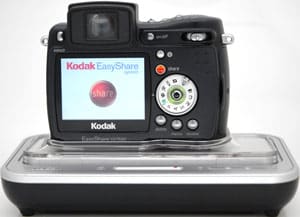
Direct Print Options**(8.0)*
In the tradition of Kodak cameras, the DX7590 was built with direct printing in mind. The red Share button allows the user to print a single picture or all the pictures stored in memory; it can also email pictures or mark them as favorites. This Kodak model comes with the EasyShare Camera Dock 6000, which links the camera to compatible printers and allows one-touch printing.
Memory (8.0)
Users can choose whether to store image files to the 32MB of internal memory or to the SD/MMC card. When recording to the camera’s internal memory, users can choose to store photographs in designated albums: Birthday, Holiday, and Wedding.
**Other features ***(6.5)*
*Favorites - *Located on the function mode dial, the Kodak EasyShare DX7590 can save photos into a Favorites album.
Overall Impressions
**
Value ***(7.0)*
Value is in the eye of the beholder. If its megapixels you want, look no farther. This is near the maximum amount of available resolution you can get at this price; 5 megapixels at $499.95. However, if you want fluid video capture in movie mode, look elsewhere. The Kodak EasyShare DX7590 only shoots 12 frames per second and doesn’t offer image stabilization. Some other models within this price range offer 30 frames per second. On top of the megapixels, the DX7590 does have a large 10x optical zoom lens that can adapt to most shooting situations — macro to telephoto.
Comparisons
[

Kodak EasyShare DX6490*](../content/Digital-Camera-Review-Kodak-EasyShare-DX6490.htm) — *The predecessor of the DX7590, the Kodak EasyShare DX6490 has many of the same features and identical styling as the DX7590, but is still one step down the Kodak ladder. At $399.95, the camera looks like a digital SLR and has slightly smaller dimensions, at 3.2 x 3.1 x 3.9 inches and 11.9 ounces. This 4-megapixel camera has the same 38-380mm optical zoom lens, but half of the memory of the DX7590 with 16MB. The 2.2-inch LCD, electronic viewfinder, and same automatic and manual control options make this camera a contender given its price tag. The choice lies in the cheaper price of the DX6490 or the increased megapixels and memory of the EasyShare DX7590.
[

Canon PowerShot S1 IS*](../content/Canon-PowerShot-S1-IS-Digital-Camera-Review.htm) - *The 3.3-megapixel Canon S1 IS retails for a similar $499 and has excellent color reproduction capabilities. With its 38-380mm lens and electronic viewfinder, the Canon S1 IS offers many of the same features as the Kodak DX7590. It measures slightly smaller at 4.3 x 3 x 2.6 inches. Its 1.5-inch LCD monitor folds out of the camera body, much like a camcorder’s would. The movie mode shoots at a fluid 30 frames per second at 640 x 480 resolution. Plus, the camera has an essential image stabilization system, helping utilize the full range of its zoom capabilities without needing to rely as heavily on a tripod. Additionally, the function dial is on top of the camera instead of on the back, which could cramp users’ style, depending on what they’re comfortable with. The Canon S1 IS has manual focus, unlike the Kodak DX7590. However, the Kodak model has a flash accessory connector, whereas the Canon S1 IS does not.
[

Fuji** FinePix S5100*](../specs/Fuji/FinePix%20S5100.htm) - *The Fuji FinePix S5100 was announced in July 2004 and has many characteristics similar to the Kodak DX7590. It retails for $499.99 and measures in at 4.4 x 3.1 x 3.2 inches and 11.9 ounces. It has a similar SLR shape and 10x optical zoom lens at 37-370mm. The biggest difference between the Kodak and the Fuji is the megapixel count. The Kodak has 5MP; the Fuji has 4 MP. The Fuji S5100 has a smaller 1.5-inch LCD screen, similar electronic viewfinder, but a faster 30 frame-per-second video recording rate. Plus, the Fuji S5100 can shoot in RAW format as well as JPEG image files.
*
**[*

Olympus** Zoom C-765*](../specs/Olympus/Ultra%20Zoom%20C-765.htm) - *The Olympus Zoom C-765 is considerably smaller at 2.7 x 2.3 x 4.1 inches and 9.9 ounces. This camera comes with 4.2 megapixels and a 10x optical zoom 38-380mm lens. For $449, the Olympus point-and-shoot model has a smaller 1.8-inch LCD screen with 118,000 pixels. The Olympus C-765 captures 15 frames per second at 320 x 240 resolution when shooting in movie mode. Announced in February 2004, this model has a similar electronic viewfinder and built-in flash and can also shoot in TIFF and JPEG formats.
Who It’s For
*Point-and-Shooters - *Beginners will appreciate the 16 scene modes and full automatic mode included on the function dial. Pictures and descriptions of each function educate the user and enable them to make the best choice about which setting to use. The camera also provides more substance than the average entry level point-and-shoot. With the SLR shape, advanced features and long zoom lens, the Kodak EasyShare DX7590 makes an entry level user look like a pro.
Budget Consumers** - **There is a cluster of cameras with similar features and a 10x optical zoom lens in the $500 range. However, the Kodak EasyShare DX7590 has the most megapixels of all of them.
Gadget Freaks** - **This camera could satisfy the gadget freak for a brief period. With some manual control features and functions, the Kodak DX7590 has the basic package to please the gadget-minded. With extras such as the flash connector, 32MB internal memory, Schneider-Kreuznach 10x optical zoom lens, and accessory flash capabilities, this Kodak model could surpass other EasyShare models in the ways of gadgetry.
Manual Control Freaks** - **There is a manual mode on this camera. It allows you to control the basics: shutter speed, ISO, flash setting, aperture, image size, etc. However, if you are hoping for manual focus or the manual white balance setting, you will be disappointed in this model.
Pros/Serious Hobbyists** - **The Kodak EasyShare DX7590 could serve as a backup camera for a pro or serious hobbyist but really would only fulfill the primary camera needs of the beginning photographer or point-and-shooter.
Conclusion
Conclusion
The Kodak EasyShare DX7590 packs a load of features into a relatively compact 12.3 ounces. The 10x optical zoom lens, flash accessory connector, and 32MB of internal memory launch this camera into the ranks with higher end models. These features, paired with 5 megapixels, make the EasyShare DX7590 a good buy at $499.95. This camera would be great for an entry level or intermediate user. The controls allow for automatic or easy functionality, while still leaving room to grow into the more manual modes. There are 16 preset scene modes, plus manual, semi-automatic, and automatic functions. This camera does lack in the movie clip area, shooting 12-20 frames per second without image stabilization as well as lacking an essential custom white balance setting. The camera struggles to control noise and scars most images shot in less-than-ideal lighting, however, the DX7590 does provide strong color reproduction capabilities and sharp image definition with 5 megapixels of resolution. Despite the camera’s difficulty handling noise, the Kodak EasyShare is still a strong buy for a 5 megapixel camera with 10x optical zoom, simplistic functionality, and a variety of features.
Specs
Specs Table
{{manufacturer_specs_table}}{{raw_scores_table}}
Meet the tester

Emily Raymond
Editor
Emily Raymond is a valued contributor to the Reviewed.com family of sites.
Checking our work.
Our team is here to help you buy the best stuff and love what you own. Our writers, editors, and experts obsess over the products we cover to make sure you're confident and satisfied. Have a different opinion about something we recommend? Email us and we'll compare notes.
Shoot us an email